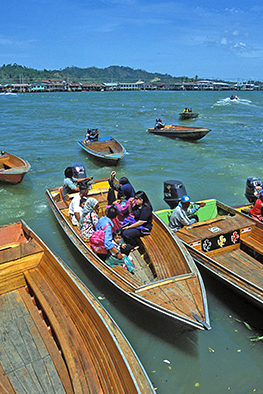Published on February 6, 2015

A special phenomenon of a total lunar eclipse will occur on Saturday, 4th April 2015. The eclipse will be the first of two Total Lunar Eclipses to occur in 2015, with the second following on Monday, 28th September 2015. This first total lunar eclipse of the year will be visible over Indonesia just after the sun sets and the moon rises.
In the capital city of Jakarta, this special phenomenon will be visible from 17:52:26 to 21:58:58 West Indonesia Time. The Jakarta Planetarium and Observatory is making all the necessary preparations for this special phenomenon.
A slight difference from a total solar eclipse (which will also occur over the Indonesian sky in 2016), the total lunar eclipse can be observed directly with the naked eye. However, binoculars and unfiltered stellar telescopes can help to observe the phenomenon even clearer.
The color of the moon while it is on the umbra or dark shadow of the earth area during the total eclipse will depend on the earth’s outer space condition. On 4thApril 2015, a spectacular view will be presented to all observing eyes since the moon will feature a blood red color, which is commonly known as the “Blood Moon” for about 5 minutes during the peak phase of the eclipse. The red color appears when the moon is at the Earth’s umbra area caused by the refraction of sunlight by the earth’s atmosphere. The red color unfortunately also reflects the high level of pollution. The higher the pollution level of an area (in this case Jakarta), the more red the color of the moon. The peak of the total solar eclipse will occur for 5 minutes from 18:57:54 to 19:02:37 West Indonesia Time.
On 4th April 2015, the total lunar eclipse will be visible only in Asia (including Indonesia), Australia, Pacific, and America. Other regions will not be able to observe the total solar eclipse since the moon’s position is below the sky or the horizon of the observer.
Lunar eclipse occurs during full moon and when the moon enters the earth’s shadow area. The earth shadow area consists of the grey shadow area or penumbra and the dark shadow area or umbra. When the moon enters the penumbra area, the vague or penumbra lunar eclipse occurs which is vaguely visible to the naked eye and can only be observed via telescope, or other devices. When the moon enters the earth’s umbra area, the visual or umbra occurs. When the moon only partially enters the umbra area, the eclipse is called partial lunar eclipse; when the entire moon’s disc enters the umbra, then we have what is known as the total solar eclipse.
Lunar Eclipse is a fascinating phenomenon to be observed, since one can also evaluate the precision of ephemeris calculations (the coordinates of space objects). During the lunar eclipse, the earth, moon, and sun are perfectly aligned and the gravitational pull of the moon and the sun can cause a maximum sea tide.
The second total lunar eclipse which will occur on 28th September 2015 will not be visible in Indonesia. This is because the eclipse will occur at daylight, and the moon is below the horizon of the observer. This second total lunar eclipse will be visible in east pacific, America, Europe, and West Asia.

Source : F. Espernak. NASA’s GSFC.
For more information contact :
Jakarta Planetarium and Observatory, The Office of Education of Jakarta
Jalan Cikini Raya no. 73
Central Jakarta
Telephone : (021) 2305146 and 2305147






